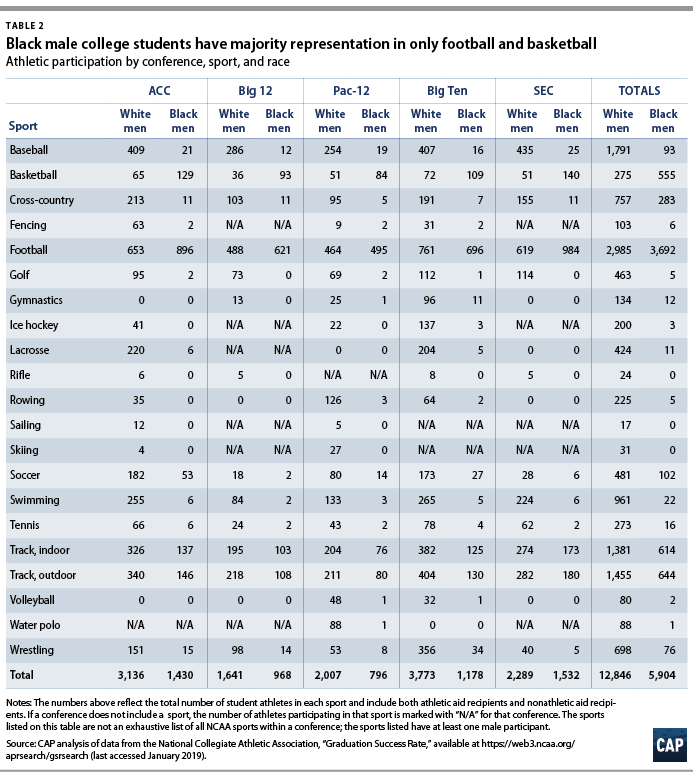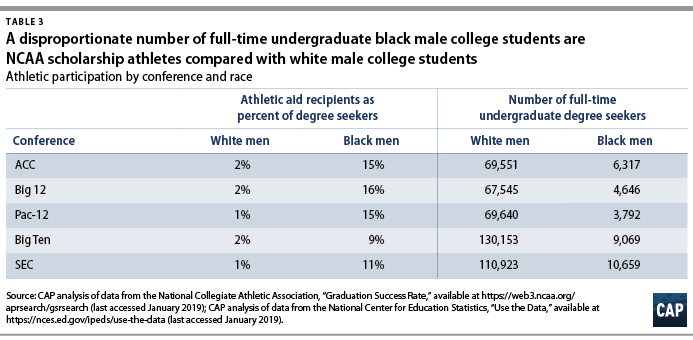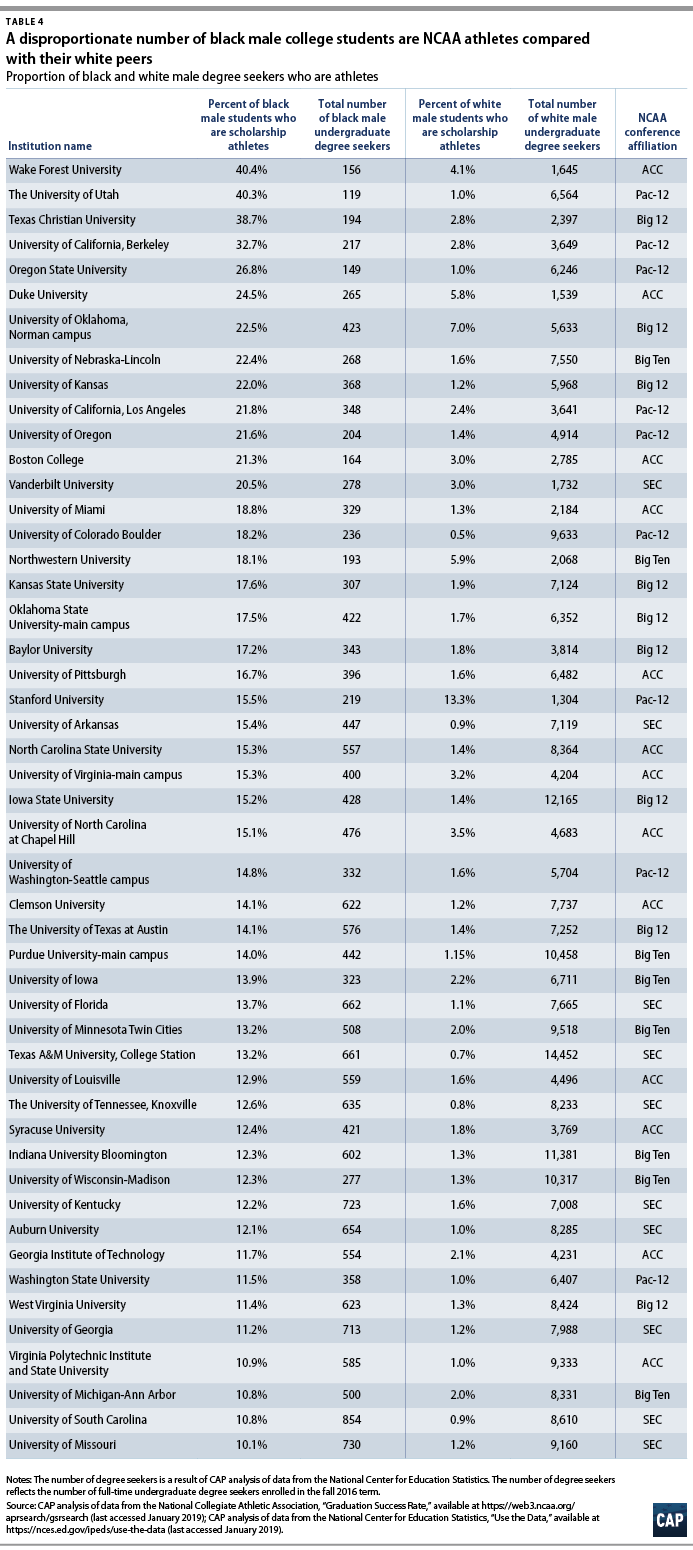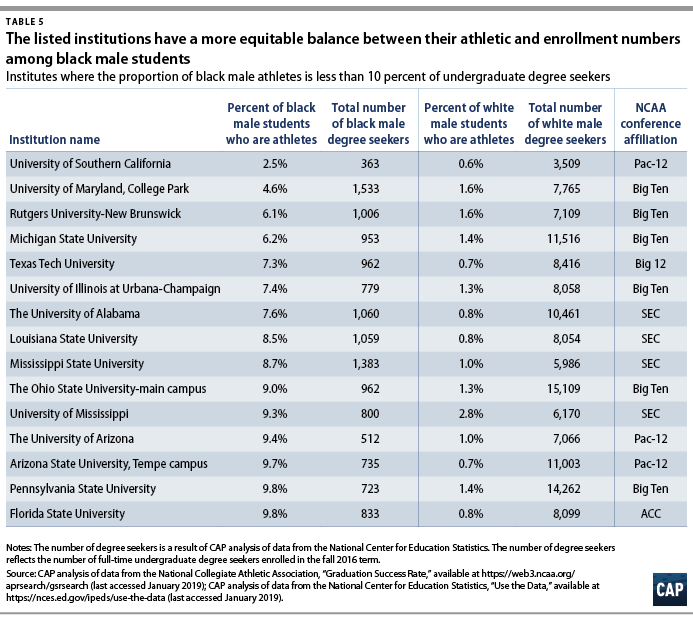With March Madness well underway, more than 90 million people1 will be glued to their televisions watching the men’s college basketball tournament. This weekslong competition, in conjunction with the revenue generated from the College Football Playoff (CFP) series, will likely generate up to $1 billion2 for the National Collegiate Athletic Association (NCAA). Colleges make a significant amount of money as well: In 2016, the Atlantic Coast Conference (ACC) sent six schools to the tournament’s round of 16, bringing in a collective $39.9 million for the conference.3 Simply making it to the March Madness tournament can bring a school more than $1 million in revenue—even if its team doesn’t win a single game.4 What receives less attention and is less easily observed on a TV screen, athletic court, or ballfield are the ways that college sports play into and obscure the inequities that black male students face in higher education.
Many of the country’s top-tier public and private universities comprise the NCAA’s elite Power Five conferences—the Big 12, the Big Ten, the Southeastern Conference (SEC), the ACC, and the Pac-12. These institutions often send teams to the CFP and Division I men’s basketball national championship games. Although black male students are overrepresented on high-profile NCAA basketball and football teams, they actually represent the minority of athletes and athletic aid recipients in the Power Five conferences. In these conferences, there are more than twice as many white male athletes as black male athletes.5
The real imbalance becomes clear when comparing the number of black males—both athletes and students in general—to the overall student populations on these campuses. Currently, black men represent less than 10 percent of total full-time, undergraduate male degree seekers at nearly all of the colleges in each of the Power Five conferences. In fact, black men are so underrepresented at Power Five conference schools that black male athletes represent a sizable chunk of these colleges’ full-time, undergraduate black male student populations. For example, in the Big 12, more than 1,280 white men are classified as NCAA athletes receiving some form of athletic aid, but they represent only 2 percent of full-time, undergraduate white men enrolled in Big 12 schools. By contrast, 725 athletic aid recipients in the Big 12 are black men, representing 16 percent of full-time, undergraduate black male enrollment—eight times that of white men. Similarly, in the Pac-12 and ACC conferences, black scholarship athletes represent 15 percent of total black male enrollment, compared with only 1 percent for white male athletes—and the SEC isn’t far behind.6
This state of affairs highlights how a collegiate system portrayed as beneficial to young black men is in fact distorting the reality of their experience in American higher education.
This issue brief is based on a Center for American Progress analysis of 2016-17 NCAA data7 that looks at both the total number of athletes per conference and at the number of athletes who receive some form of scholarship or athletic aid at an institution in one of the Power Five conferences. (To see the full methodology, please refer to the Methodological Appendix.) According to the data, white men represent 55 percent of the more than 23,000 male athletes in the NCAA Power Five conferences, while black men represent only one-quarter of those same athletes. While the most high-profile sports, such as football and basketball, feature a large share of black athletes, all other college sports predominantly field white athletes.8
Despite their much smaller numbers, black male athletic aid recipients represent a significant share of the overall population of full-time, degree-seeking, undergraduate black male college students at institutions in the Power Five. At Wake Forest University in the ACC, of the 156 full-time, undergraduate degree seekers who are black men, 63, or 40 percent, are athletes, while only 4 percent of white male undergraduates are athletes. Similarly, of the 217 full-time, degree-seeking, undergraduate black men enrolled at the University of California, Berkeley in the Pac-12, 32 percent are athletes, compared with 3 percent of white male undergraduate students.
These gaps in both the number of athletic aid recipients and their share of overall student enrollment raise two primary concerns about college admissions and the NCAA.
First, when black male athletes represent a large proportion of a college’s total black male enrollment, it perpetuates damaging stereotypes that could signal to young students—and young black men in particular—that athletic programs are the primary pathway to higher education for black men. Because of these stereotypes, students, teachers, and coaches may disproportionately emphasize athletics to young men of color over academics as the best path to a college degree.9 This perception has serious implications for young men of color,10 who not only have lower college graduation rates overall11 but also have lower graduation rates in comparison to white male athletes.12
Second, black male college athletes are getting a bad deal. They are underrepresented in the Power Five colleges and in the majority of college sports programs. Their work on the court and the field generates vast profits for the NCAA,13 member colleges,14 and TV networks,15 yet student-athletes receive no share of the profits they generate.16 Moreover, the majority of black student-athletes participate in sports with the highest risks of physical injury17 and academic insecurity,18 the latter of which is due to these sports’ emphasis on remaining eligible and in good physical condition to play, rather than on allowing students to be academically competitive.
To address these glaring inequities, the NCAA and colleges alike need to be more intentional in their diversity and recruitment efforts. While athletics remain an important pathway to college for a small number of students, colleges must dramatically increase their efforts to recruit and retain black male students regardless of their athletic ability. They must also dismantle unfair admissions practices that systematically exclude black applicants. Likewise, NCAA athletic programs should reflect the commitment to diversity and inclusion that they claim to embrace by promoting the participation of young people of color in sports that traditionally have been dominated by white students or by creating an alternative scholarship program for students from underserved communities.19 It is also past time for student-athletes to receive compensation and career-readiness support, including expanded opportunities for employment prior to graduation. If not, these gaps will continue to persist: Black men will continue to be underrepresented on college campuses and overrepresented in just a fraction of college athletics.
4 major findings from the NCAA data
1. Black men comprise the minority of athletes in NCAA athletic programs
NCAA conference data show that white men represent 55 percent of the more than 23,000 total male athletes in the NCAA Power Five conferences. In comparison, black men represent only one-quarter of those athletes. Unfortunately, the numbers don’t look much better when restricted to athletes who receive some form of athletic aid: In every conference in the Power Five, white men are also the majority of aid recipients. (see Table 1)

2. The majority of black male athletes generate revenue, but they don’t profit
White men are represented in a wide variety of sports programs, whereas most black men are concentrated in the few revenue-generating sports.20 For example, in the Power Five conferences, 63 percent of all black male athletes participate in football, compared with just 23 percent of white male athletes. Additionally, of the black male athletes in the Power Five, 9 percent play basketball, compared with just 2 percent of white male athletes. This means that more than 70 percent of black male athletes in the Power Five participate in only two sports. By contrast, nearly 1,800 white male athletes play baseball in the Power Five conferences, compared with just 93 black men. Similarly, more than 400 white men play lacrosse and golf for the Power Five conferences, compared with only 11 and 5 black men, respectively. (see Table 2)

The two sports with the largest concentrations of black male athletes—football and basketball—bring in some of the largest streams of revenue for many universities21 and carry the greatest risks of injury.22 This year, athletes in the NCAA men’s basketball tournament are expected to generate $869 million for the organization.23 Similarly, NCAA football players generate millions of dollars in profit each year for the colleges in the Power Five conferences. But these athletes don’t see any additional compensation beyond their scholarships, which don’t always cover living and other expenses associated with attending college.24 Although the Power Five conferences recently voted to provide additional funds to cover expenses and other college-related costs for full-scholarship athletes,25 the rules vary by school, and not every athletic aid recipient receives substantially more for other expenses,26 meaning that many athletes still struggle to cover basic living expenses.27
There are also long-term health costs associated with participating in NCAA sports programs. The NCAA and the National Athletic Trainers’ Association report that one-third of college football players have sustained one concussion and another 30 percent have had two or more concussions while in college.28 College football and basketball players also risk sustaining other debilitating injuries, especially to the ankles and knees.29 All of these injuries can mean that athletes face significant health care costs long after they leave college and lose access to the health insurance provided by their college or program.30
Furthermore, many athletes have little time to take advantage of their college’s various academic resources, especially when they participate in high-profile, revenue-generating sports and are forced to spend time training and traveling.31 For these athletes, and for black men in particular,32 it can be a challenge to prioritize academics and stay on track to graduate.33 In fact, a recent study found that two-thirds of universities in the Power Five conferences had lower graduation rates for their black male athletes than for the nonathlete black men on campus.34 At some schools,35 athletes have even been shunted into less rigorous courses and degree programs, which can affect their ability to build a professional career after college—particularly if they are part of the 98 percent of college athletes who don’t go on to play professional sports.36
3. White men have more opportunities to earn athletic scholarships
The NCAA data show that white men participate at higher rates in less-revenue-generating sports such as lacrosse, swimming, soccer, baseball, and wrestling, whereas black athletes are the majority in just two sports: basketball and football. These gaps in equitable representation are not due to a lack of skill but rather a lack of resources. Historically, public schools that serve large populations of low-income students and students of color are underfunded and understaffed.37 Sports such as lacrosse, fencing, rowing, ice hockey, and golf can be expensive. In fact, many public K-12 schools do not offer these programs for free, if they offer them at all. That being the case, students attending these schools may only be able to participate through local club teams or by paying a fee.38 What this means is that many low-income students, often students of color, are priced out of many sports programs.39
As a result, thousands of students in low-income and under-resourced areas do not get the opportunity to participate in sports programs that offer scholarship aid; carry a lower risk of injury;40 and provide pathways to top-tier institutions, such as those in the Power Five conferences. Just as importantly, these sports rarely carry the expectation of a career as a professional athlete, allowing participating student-athletes to focus more on academics.41 In addition, some of these other sports are nonrevenue-generating, meaning that while they still carry extensive time demands, there is less institutional pressure to perform at the highest levels. And wealthier, mostly white students benefit most from the admissions advantage these more expensive sports provide, further perpetuating inequity in college admissions.42
4. A disproportionately large share of black men on campus are athletes
In addition to the racial disparities in athletic program participation, there are large racial gaps in the shares of full-time, degree-seeking, undergraduate students that male athletes represent.
As mentioned above, more than 1,280 white men in the Big 12 conference are classified as athletic aid recipients, but they represent just 2 percent of white men enrolled in Big 12 schools. By contrast, 725 black men are athletic aid recipients in the Big 12, but they represent 16 percent of total black male enrollment—eight times the percentage of white male athletes. Similarly, in the SEC, black athletic aid recipients comprise 11 percent of total black male enrollment, compared with only 1 percent for white male athletes. (see Table 3)

At the institutional level, black male enrollment is often so abysmally low that if black male athletes receiving athletic aid were excluded from enrollment counts, there would be a significant decrease in the number of full-time, degree-seeking, undergraduate black men on campus. This is largely a result of overall black male enrollment being extremely low at institutions in the Power Five conferences in comparison to overall enrollment of their white peers. The University of Oklahoma (OU), which is in the Big 12 conference, enrolled just 423 full-time black male undergraduate degree seekers in 2016. Of those students, 22 percent were scholarship athletes. In comparison, OU enrolled more than 5,600 full-time, degree-seeking, undergraduate white men in the same year, and of those, only 7 percent were scholarship athletes. (see Table 4)

If NCAA athletes with athletic aid at the University of California, Berkeley were not counted, the school’s black male undergraduate enrollment would drop by more than 30 percentage points; white male undergraduate enrollment would only drop by 3 percentage points if athletes were excluded. To put these numbers in perspective, the share of black male undergraduate degree seekers that black athletic aid recipients represents is 10 times that of white scholarship athletes.
These institutions are not alone. More than 80 percent of colleges in the Power Five conferences get 10 percent or more of their black male undergraduate enrollment from athletic programs alone. (see Table 5)
Some institutions enroll a larger number of undergraduate black male students, and though the numbers of black men enrolled are still much lower than the numbers of white men, there is a more equitable balance between athletic and overall undergraduate enrollment numbers. On the University of Southern California’s campus, for example, only 3 percent of black full-time, degree-seeking, undergraduate men are scholarship athletes, compared with 1 percent of white men.43 Similarly, at University of Maryland-College Park, only 5 percent of black men and 2 percent of white men on campus are scholarship athletes. Other universities such as Texas Tech and Michigan State enroll a larger number of full-time, undergraduate black male students, so black male NCAA athletic aid recipients represent less than 10 percent of black male, undergraduate degree seekers. It is important to note that some of the institutions listed above could be providing their athletes with institutional or academic aid—aid provided by the institution for nonathletic purposes—in lieu of athletic scholarship aid, which could account for their lower scholarship-athlete numbers. However, the fact remains that if institutions had more equitable enrollment overall, there would not be such stark differences between athletes and general undergraduate enrollment.

Closing the gaps
When institutions get a disproportionate share of their black male undergraduate enrollment through their athletic departments, the message to students, the public at large, and young black men is clear: One of the few ways for black men to gain access to a top-tier college is through sports. This narrative is symptomatic of a badly broken system of access to higher education,44 and it can cause high schools45 and colleges to emphasize athletic programs over academics.46 Such a skewing of priorities could dissuade young men of color from pursuing academic or extracurricular activities that have a higher chance of leading to future success.
In reality, only 6 percent47 of high school athletes make it to the NCAA. Many who do face a high risk of injury during their college athletic career,48 and of those who avoid serious injury, only 2 percent go on to play at a professional level.49 Instead of sending the misleading message that athletics is the primary pathway to a college education and professional success for men of color, institutions should do their part to change the narrative. Colleges specifically should do more to recruit and enroll more students of color—especially black men—outside of athletic programs, with the goal of ensuring equitable representation on campus across racial groups.
This is not to say that institutions should enroll fewer athletes. Rather, colleges should work to ensure that their admissions systems are more accessible to low-income students and students of color. Institutions can achieve this by eliminating barriers to admission that inhibit diversity efforts, such as early admissions, legacy admissions, or strict SAT and ACT requirements.50 Colleges could also increase representation by recruiting students of color in the same ways they recruit athletes—by sending representatives to high schools that have traditionally sent no or few students to their institution.
Additionally, the NCAA, using some of the millions of dollars it generates annually, should provide more opportunities for low-income youth to access cost-prohibitive sports programs. The NCAA should offer not only those scholarships already provided to athletes but also academic scholarships for students in underserved communities. Policymakers should also work to direct funds to under-resourced public schools so that students can have access to educational resources and other extracurricular and sports programs that colleges consider in admissions.
Colleges and the NCAA should practice what they preach51 and prioritize academics and post-graduation outcomes above athletics. Too many colleges52 place athletes in less academically rigorous programs—keeping students eligible but not educated—which harms athletes’ prospects of earning a degree and achieving future success.
As recommended in prior research,53 the NCAA should also start a commission on racial equity dedicated to exploring the collection of data on other important student characteristics in addition to race, such as sex, sport, LGBTQ status, and income; making that data public; and working to close existing inequities in graduation rates.
Moreover, a portion of the NCAA’s nearly $1 billion in annual revenue54 should be used to provide some form of compensation to its athletes in revenue-generating sports, especially to low-income athletic aid recipients. If they were compensated fairly, student-athletes would not struggle to cover basic living costs55 and could not only save for their futures but also focus more acutely on academics and post-graduation plans. Considering that many NCAA football56 and basketball57 coaches receive millions of dollars in compensation, it is past time that the NCAA provide its athletes in revenue-generating sports with compensation that reflects the dedication, time commitment, and risk those athletes undertake. At a minimum, the NCAA should support any efforts of its players to unionize, so that athletes can bargain collectively and actively participate in the decisions that dictate their time, benefits, and future.58
The NCAA should also increase opportunities for student-athletes to build and utilize marketable work experience. This begins with reforming current restrictions on outside and self-employment—such as the ban on student-athletes’ use of their own names, photographs, or athletic reputations to promote their own businesses.59 While the NCAA’s After the Game Career Center provides some professional resources to former student-athletes, these services must be expanded to include current student-athletes, even if an injury renders them ineligible to play.60 The NCAA should also create a pipeline for athletes to pursue internships, externships, and post-graduation employment, such as through its Corporate Champion and Partner Program.61
Student-athletes who generate millions of dollars in revenue for their schools and practice tirelessly, investing time and energy to remain competitive in their sport, should not be shortchanged in their pursuit of a degree. More specifically, the NCAA and colleges alike need to better support the black men on their campuses and in their athletic programs.
Conclusion
The current system of college athletics places significant capital on the athletic abilities of black men but little in their ability to complete a degree. It is time for that balance to shift. Colleges should ensure that black men have more equitable representation on campus, and the NCAA must do more to prioritize degree completion over athletic participation. Until the NCAA and colleges work together to create a more equitable system of participation, representation, and degree completion in their athletic programs, black men will continue to be denied agency over their futures and fail to see benefits beyond the points they put up on the scoreboard.
Sara Garcia is a senior research and advocacy manager for Postsecondary Education at the Center for American Progress. Connor Maxwell is a policy analyst for Race and Ethnicity Policy at the Center.
Methodological appendix
The analysis for this brief used data from three primary sources. The first was NCAA enrollment data for athletic aid recipients from the Graduation Success Rate (GSR) reports for each institution in the Power Five conferences for the 2016-17 academic year.62 The second data source was the conference figures from the Sport Sponsorship, Participation and Demographics Search report for the 2016-17 academic year. This NCAA report was used to generate the total number of athletes in each sport for every conference by race. Third, in order to understand the number of full-time, degree-seeking, undergraduate students enrolled at each institution in the Power Five conferences for 2016-17, CAP used enrollment data from the Integrated Postsecondary Education Data System (IPEDS).63
Although the NCAA does not provide a single database to analyze the number of athletes by race for each campus, these data are available in an enrollment table in the GSR report, which discloses the number of athletic aid recipients by race and gender for each institution. CAP pulled the report for each college in the Power Five conferences and then combined the data from the reports into one spreadsheet. In order to calculate the share of undergraduate degree seekers that athletic aid recipients represent, CAP divided the number of athletic aid recipients by the total number of full-time, undergraduate degree seekers for each conference and institution by race.
A few details about the data used and the analyses presented should be kept in mind. First, the brief only includes the number of full-time, degree-seeking undergraduates and does not represent the total number of students on campus. Second, the data on athletic aid recipients does not distinguish between full- and partial-aid recipients. The data include any student-athlete who receives any amount of athletic aid; they do not reflect only student-athletes who receive the full cost of attendance scholarships. Lastly, the analyses in this brief focus on the enrollment and athletic participation of white and black men and do not include an analysis of female student-athletes. While it is critically important to consider gaps by race in college enrollment and athletic participation among female student-athletes, that analysis is outside the scope and focus of this brief. Future examinations of this topic should consider differences by both gender and race.